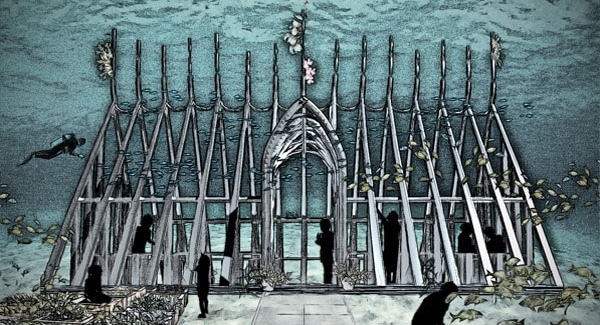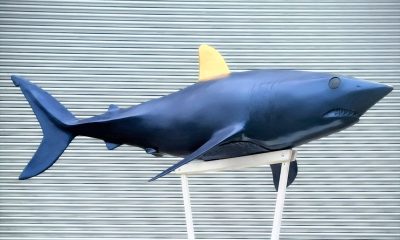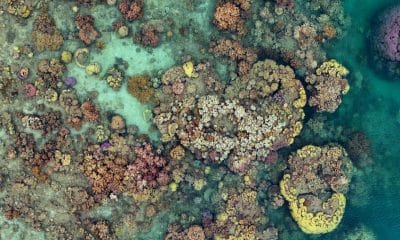News
New Underwater Museum on The Great Barrier Reef

Jason deCaires Taylor is drawing closer to the installation of his latest and most ambitious underwater art project to date: MOUA, the Museum Of Underwater Art within the Great Barrier Reef, Australia.
Undoubtedly one of Jason’s most challenging projects the new museum will feature a series of galleries located throughout Townsville, Magnetic Island, Palm Island and the Great Barrier Reef region. The first galleries are due to open to the public in December 2019.
For the first time Jason will be combining a range of inter-tidal and fully submerged artworks including pioneering large scale architectural installations and sculptural works that change in response to the environmental conditions.
MOUA is also the first major project for Jason in the Southern Hemisphere and the installation will include the first ever sculptures to be placed within the world famous Great Barrier Reef. Already more than two years in the planning, MOUA is a not for profit collaborative project funded by the Australian and Queensland Governments with Australian corporate partners. The project brings together reef, tourism and science partners including the James Cook University and the Australian Institute of Marine Science and seeks approvals through the Great Barrier Reef Marine Park Authority.
The museum aims to encourage environmental awareness, increase knowledge of marine ecosystems and help instigate social change whilst leading visitors to appreciate the breathtaking natural beauty of the Great Barrier Reef. Through interpretation centres, trained guides and thoughtful designs of both the artworks and the experience, the sculptures will convey vital messages about the threats to oceanic marine systems and our deep-rooted dependency on the sea.
The first installation, due to be unveiled in December 2019, will be a coastal based, solar powered sculpture of a young indigenous girl issuing a warning about rising sea temperatures. Using live temperature data from active sites on the Great Barrier Reef, the outer layer of the sculpture will change colour in response to changes in water temperature creating a visual representation of live conditions underwater. By using data supplied by AIMS atmospheric weather stations the work aims to connect the general public directly to marine issues as they occur in real-time. Conveying statistical scientific data in a raw, visceral and emotive way.
The second phase of the museum will feature a Coral Greenhouse situated in the heart of the Great Barrier Reef at John Brewer Reef. The large scale 12m high underwater botanical structure is designed as an art space, underwater educational centre, science laboratory and a secure space for marine life, a symbol of underwater stewardship which connects to the local community and wealth of marine science institutions in the local region.
The unique skeletal design has been engineered to dissipate ocean currents whilst providing an intricate habitat for marine life. The contemporary Greenhouse will be surrounded by sea-scaping; a series of coral nurseries, organic stems and underwater trees all designed in a way to facilitate coral rehabilitation activities.
For more information please visit the website by clicking here or follow Jason on Instagram.
Gear News
Introducing the TR-80, IR-50 and CS-30 Regulators from DYNAMICNORD

Whether you are a beginner or a professional diver – with the three new main regulators from DYNAMICNORD, everyone will find their favourite regulator. They all look super stylish.
Excellent performance with the TR-80
Quality and performance are the be-all and end-all for regulators. It is not for nothing that the TR stands for Tec Reg. The innovative design of the TR-80 guarantees absolute reliability – even in ice-cold waters.

Perfect breathing effort at 0.8 J/l / certified for diving in waters below 10 degrees / structural design made of solid brass for best cold protection / membrane-compensated design with dry seal of the first stage / reduced exhalation effort thanks to optimized exhalation membrane and bubble deflector / adjustable Venturi (dive/predive) and adjustment knob for individual inhalation comfort / innovative design of the front cover prevents free-flow in strong currents or when diving with scooters / design made of sandblasted brass, matt chrome finish / 2 HP and 4 LP outlets / mouthpiece made of high-quality, anti-allergic silicone for maximum comfort.


Amazing underwater adventures with the IR-50
The IR-50 is the top regulator for advanced and experienced divers. Natural breathing is the essence of this regulator.

Ideal breathing effort at 0.8 J/l /certified for diving in waters below 10 degrees / compensated membrane / adjustable venturi (dive/predive) and adjustment knob for individual inhalation comfort/ outlet valve and deflector for minimum exhalation effort and reduction of bubbles on the face / design made of sandblasted brass, matt chrome finish / 2 HP and 4 NP outlets / mouthpiece made of high-quality, anti-allergic silicone for maximum comfort.


The Workhorse – our CS-30
For diving centres and diving beginners – the workhorse stands for strong construction, reliability and robustness. Perfect for your training.

Optimal breathing effort at 0.8 J/l /recommended for diving in waters above 10 degrees / non-compensated piston / adjustable venturi (dive/predive) / outlet valve and deflector for minimum exhalation effort and reduction of bubbles on the face / design made of sandblasted brass, matt chrome finish / 1 HP and 3 NP outlets / mouthpiece made of high-quality, anti-allergic silicone for maximum comfort.


Octopus OP-30
The OP-30 is the ideal addition to all DYNAMICNORD regulators. It is identical in construction to the CS-30.

The TR-80, IR-50, CS-30 (DIN & INT) regulators and the Octopus OP-30 are available from DYNAMICNORD dealers and in the online store.
DYNAMICNORD – Your Outdoor Companion.
Marine Life & Conservation
Paul Watson Released as Denmark Blocks Japan’s Extradition Bid

Renowned anti-whaling activist Paul Watson has been released from custody in Greenland after spending five months in detention. Denmark’s Justice Ministry rejected Japan’s request for his extradition, citing insufficient guarantees that his time already served in custody would be credited against any potential sentence.
The 74-year-old Canadian-American was arrested on July 21 in Nuuk, Greenland’s capital, when his ship docked to refuel. His arrest was based on a 2012 Japanese warrant related to a 2010 encounter in Antarctic waters. Japan alleged Watson obstructed operations and caused damage to a whaling research ship during efforts to disrupt illegal whaling. Watson has consistently denied these claims, maintaining his commitment to marine conservation.
Denmark, which oversees extradition matters for Greenland, concluded that while the legal conditions for extradition were met, the lack of assurances from Japan regarding time-served credit made extradition untenable.
In a video shared by his foundation, Watson expressed gratitude and relief, saying, “After five months, it’s good to be out… and good to know they’re not sending me to Japan.” He added that the most difficult part of his time in custody was being separated from his two young sons.
Watson is a pioneering figure in marine conservation, known for founding the Captain Paul Watson Foundation in 2022 after decades of activism with the Sea Shepherd Conservation Society. His bold efforts to defend marine life have earned him widespread support, including from celebrities and conservationists. His work has also been featured in the acclaimed reality TV series Whale Wars.
Watson’s lawyer, Jonas Christoffersen, praised the decision, stating, “We are happy and relieved that Paul Watson is now free.” He added that Watson is eager to reunite with his family and continue his vital work.
The arrest occurred while Watson’s vessel, the M/Y John Paul DeJoria, was en route to the North Pacific with a team of 26 volunteers to intercept a Japanese whaling ship. His foundation described the arrest as politically motivated and emphasized that Watson’s actions were focused on ending illegal whaling practices.
Japan resumed commercial whaling in 2019 after leaving the International Whaling Commission, asserting that whale meat is a cultural tradition. Conservationists, however, continue to challenge these practices, highlighting their impact on marine ecosystems.
Despite the challenges, Watson remains steadfast in his mission to protect marine life and bring attention to whaling practices. His dedication to ocean conservation has made him a globally respected advocate for the environment.
-

 News2 months ago
News2 months agoIconic SS United States to become the World’s Largest Artificial Reef
-

 News3 months ago
News3 months agoBook Review – 52 Assignments: Underwater Photography
-

 Gear News3 months ago
Gear News3 months agoDYNAMICNORD – New German diving brand enters the British market
-

 News3 months ago
News3 months agoExploring Cenote El Pit: A Diver’s Dream
-

 Gear News3 months ago
Gear News3 months agoTry BARE drysuits (and maybe even win one!) this Friday with Sea & Sea at North West Dive Fest
-

 Marine Life & Conservation3 months ago
Marine Life & Conservation3 months agoBook Review: Coral Triangle Cameos
-

 Blogs2 months ago
Blogs2 months agoDive the Egyptian Red Sea this Autumn with Regaldive
-

 News3 months ago
News3 months ago2024 Ocean Art Underwater Photo Competition Announced

















